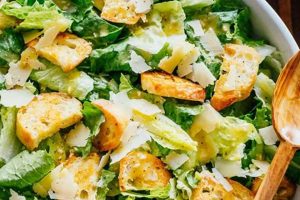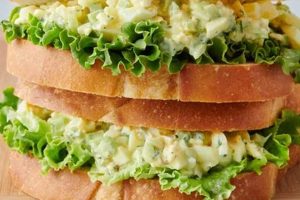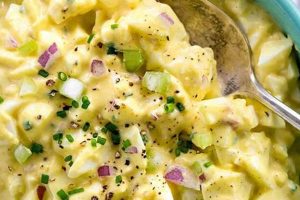Creating this classic dish involves combining cooked eggs with mayonnaise and various other ingredients. A basic version includes chopped hard-boiled eggs, mayonnaise, mustard, salt, and pepper. Variations can incorporate ingredients like celery, onion, relish, paprika, or fresh herbs. The mixture is typically served cold as a sandwich filling, a salad topping, or with crackers.
This simple yet versatile dish offers a convenient and nutritious meal option. Eggs are a rich source of protein and essential nutrients. The ease of preparation and adaptability to different flavor profiles have made egg salad a popular choice for generations, appearing in cookbooks and at picnics for decades. Its affordability and ability to be prepared ahead of time further contribute to its enduring appeal.
The following sections will detail ingredient selection, egg cooking methods, mixing techniques, and serving suggestions to guide the creation of a perfect egg salad.
Tips for Perfect Egg Salad
Achieving optimal egg salad requires attention to detail in each preparation step. The following tips offer guidance for creating a delicious and satisfying outcome.
Tip 1: Perfect Hard-Boiled Eggs: Avoid overcooking eggs, which can lead to a dry, rubbery texture and a green ring around the yolk. Gently place eggs in boiling water, cook for 8-10 minutes, then immediately transfer them to an ice bath to stop the cooking process.
Tip 2: Chopping Consistency: Uniformly chopped eggs contribute to a pleasant texture. A coarse chop provides a more substantial bite, while a finer chop creates a smoother consistency. Consider using an egg slicer for even results.
Tip 3: Mayonnaise Matters: The quality and quantity of mayonnaise significantly influence the final product. Use a good quality mayonnaise and add it gradually, adjusting to the desired creaminess. Over-dressing can result in a bland and watery salad.
Tip 4: Seasoning Strategically: Salt and pepper are essential base seasonings. Adding these after the eggs are chopped ensures even distribution. A touch of Dijon mustard enhances the flavor profile.
Tip 5: Elevating with Add-ins: Fresh herbs like dill or chives add brightness. Finely diced celery or red onion provides a satisfying crunch. A dash of paprika offers a subtle smoky note.
Tip 6: Chilling for Optimal Flavor: Allowing the egg salad to chill in the refrigerator for at least 30 minutes before serving allows the flavors to meld and enhances the overall taste experience.
Tip 7: Creative Serving Suggestions: Explore beyond the traditional sandwich. Egg salad can be served on lettuce cups, as a filling for deviled eggs, or as a topping for avocado toast.
By following these tips, one can consistently produce egg salad that is both flavorful and visually appealing. Attention to these details elevates a simple dish to a culinary delight.
The following section will offer concluding remarks and further inspiration for enjoying this classic dish.
1. High-quality Ingredients
Ingredient quality significantly impacts the final flavor and texture of egg salad. Fresh, high-quality eggs possess a richer flavor and firmer texture compared to older eggs. The yolk color is more vibrant, contributing to a visually appealing final product. Similarly, using a high-quality mayonnaise, preferably one made with real eggs and minimal additives, enhances the overall richness and creaminess of the egg salad. Selecting fresh herbs and crisp vegetables, rather than wilted or bruised produce, contributes to both the flavor and aesthetic appeal of the dish. For example, using farm-fresh eggs results in a noticeably superior taste compared to using eggs that have been stored for extended periods. Likewise, opting for a stone-ground mustard adds a depth of flavor not found in generic yellow mustard.
The selection of high-quality ingredients demonstrates an attention to detail that elevates the egg salad from simple fare to a truly enjoyable culinary experience. Freshly cracked black pepper offers a more robust aroma and flavor than pre-ground pepper. Choosing flavorful add-ins like capers, cornichons, or high-quality smoked paprika can transform the egg salad into a gourmet delight. Furthermore, using high-quality ingredients often means fewer additives and preservatives are consumed, which can be a health benefit. For instance, homemade mayonnaise allows for control over the oil and acid used, potentially creating a healthier and more flavorful option.
Ultimately, while a palatable egg salad can be made with standard ingredients, the use of high-quality ingredients demonstrably enhances the sensory experience. The difference is discernible in the vibrancy of the flavors, the pleasant texture, and the overall satisfaction derived from consuming a dish crafted with care and attention to detail. This principle extends beyond egg salad; prioritizing quality ingredients consistently improves the outcome of any culinary endeavor.
2. Precise Cooking Techniques
Precise cooking techniques are essential for achieving optimal texture and flavor in egg salad. The degree to which eggs are cooked directly impacts the final result. Overcooked eggs become dry and rubbery, while undercooked eggs can be unsafe to consume. Mastering the cooking process is crucial for creating a successful egg salad.
- Controlling Water Temperature
Maintaining a consistent, gentle boil prevents the eggs from cracking and promotes even cooking. Rapidly boiling water can cause the eggs to jostle and crack, leading to uneven cooking and a less appealing appearance. A gentle simmer ensures that the egg whites solidify evenly and the yolks cook to the desired consistency, crucial for a smooth and creamy egg salad.
- Timing the Cooking Process
The cooking time dictates the final texture of the yolks. A shorter cooking time results in a softer, more jammy yolk, while a longer cooking time yields a firmer, drier yolk. For classic egg salad, a cooking time of 8-10 minutes is generally recommended for a firm yet moist yolk that blends well with other ingredients. Precise timing prevents overcooking and the resultant unpleasant sulfurous odor often associated with overcooked eggs.
- Cooling the Eggs Rapidly
Immediately transferring cooked eggs to an ice bath halts the cooking process and prevents the yolks from developing a greenish-gray ring. This rapid cooling also makes the eggs easier to peel. The ice bath ensures the eggs reach the desired doneness without residual heat continuing to cook them, preserving their ideal texture for egg salad.
- Peeling the Eggs Efficiently
While not directly related to cooking, efficient peeling minimizes egg white loss and maintains the egg’s structural integrity. Gently tapping the cooked egg all over creates cracks in the shell, facilitating easy removal. Adding a tablespoon of vinegar or baking soda to the boiling water can also aid in the peeling process. Preserving as much of the egg white as possible contributes to a more substantial and satisfying egg salad.
By adhering to precise cooking techniques, one ensures that the eggs are cooked to the ideal consistency for egg saladfirm enough to hold their shape when chopped, yet moist enough to create a creamy and flavorful mixture. This attention to detail elevates the final product, resulting in an egg salad that is both visually appealing and enjoyable to eat. The properly cooked egg provides the foundation for a successful egg salad, influencing both its texture and its ability to absorb and complement the flavors of the other ingredients.
3. Proper Egg Chopping
Proper egg chopping significantly influences the final texture and overall enjoyment of egg salad. The size and uniformity of the chopped eggs affect how the salad binds together, how it spreads on bread, and the mouthfeel experienced when consumed. Uniformly chopped eggs ensure even distribution of mayonnaise and seasonings, creating a harmonious blend of flavors and textures. Conversely, inconsistently chopped eggs can lead to a mixture that is both visually unappealing and texturally uneven, with some bites containing large chunks of egg while others are mostly mayonnaise.
Several chopping methods yield different results. A coarse chop, achieved by roughly cutting the eggs into larger pieces, creates a chunkier egg salad with a more substantial bite. This method is preferred by those who enjoy a more textured experience. A finer chop, created by meticulously dicing the eggs into smaller pieces, yields a smoother, more uniform salad that spreads easily and offers a creamier mouthfeel. This method is often preferred for sandwich fillings or when a more delicate texture is desired. Using an egg slicer provides a convenient and efficient way to achieve uniformly sliced eggs, ideal for a visually appealing and evenly textured salad. The chosen chopping method directly impacts the final presentation and perceived quality of the egg salad.
The connection between proper egg chopping and a successful egg salad recipe lies in the balance between aesthetics, texture, and flavor distribution. Chopping the eggs uniformly ensures that each bite contains a balanced proportion of egg, mayonnaise, and seasonings. This contributes to a more satisfying and enjoyable eating experience. Furthermore, properly chopped eggs enhance the visual appeal of the egg salad, making it more appetizing. While personal preference dictates the ideal chop size, consistency remains crucial for a well-executed egg salad. Mastering this seemingly simple step elevates the dish from a basic mixture to a carefully crafted culinary creation.
4. Balanced Seasoning
Balanced seasoning is paramount in a successful egg salad recipe. It elevates the dish beyond simple ingredients, transforming it into a flavorful and enjoyable experience. The interplay of salt, pepper, and other seasonings enhances the inherent flavors of the eggs and other components, creating a harmonious blend that satisfies the palate. Without proper seasoning, egg salad can be bland and unappealing, regardless of the quality of the other ingredients.
- Salt’s Foundational Role
Salt acts as the foundation of seasoning, enhancing the natural flavors of the eggs and other ingredients. It amplifies sweetness and mitigates bitterness, creating a balanced flavor profile. The correct amount of salt is crucial; too little results in a bland salad, while too much overpowers the other flavors. For example, using kosher salt allows for more controlled salting due to its larger crystal size.
- Pepper’s Complexity
Freshly ground black pepper adds depth and complexity to egg salad. Its subtle heat and earthy notes complement the richness of the eggs and mayonnaise. Pre-ground pepper often lacks the same intensity and aroma, diminishing its impact on the overall flavor profile. The type of pepper used, such as white pepper for a milder flavor or a blend of peppers for a more nuanced taste, can further influence the final outcome.
- Acidity’s Balancing Effect
A touch of acidity, often achieved through the addition of vinegar, lemon juice, or mustard, brightens the egg salad and balances the richness of the mayonnaise. This acidic element cuts through the fattiness, creating a more refreshing and palatable experience. For example, a teaspoon of Dijon mustard provides both acidity and a subtle tang, adding another layer of complexity to the flavor profile.
- Herbs and Spices’ Nuances
Fresh herbs like dill, chives, or parsley, along with spices like paprika or cayenne pepper, can add nuanced flavors to the egg salad. These additions elevate the dish beyond the basic flavor profile, offering a customized taste experience. The choice of herbs and spices depends on personal preference and the desired flavor profile. For example, fresh dill adds a bright, slightly tangy flavor, while smoked paprika introduces a smoky depth.
The careful balance of these seasoning elements is what distinguishes a truly exceptional egg salad. Each ingredient plays a specific role, contributing to the overall flavor profile and ensuring a harmonious blend of tastes. By understanding the function of each seasoning component and experimenting with different combinations, one can create a customized egg salad recipe that perfectly suits individual preferences. The interplay of these elements transforms simple ingredients into a complex and satisfying culinary creation.
5. Thoughtful Add-ins
Thoughtful add-ins elevate egg salad from a simple staple to a customizable culinary creation. These additions introduce textural complexity, enhance the flavor profile, and offer a means of personalizing the dish. The selection and incorporation of add-ins directly impact the final product’s appeal and satisfaction. Add-ins contribute not only to the taste but also to the visual appeal and overall sensory experience of the egg salad. Consideration of flavor pairings, textural contrasts, and color combinations are crucial for achieving a well-balanced and appealing result.
Several categories of add-ins offer distinct contributions. Crunchy elements, such as finely diced celery, red onion, or water chestnuts, provide textural contrast to the creamy base. These additions create a more dynamic and enjoyable mouthfeel. Flavorful additions, such as chopped fresh herbs (dill, chives, parsley), capers, or olives, introduce complexity and depth. These ingredients can complement or contrast the existing flavors, creating a more nuanced and interesting taste experience. Ingredients offering both texture and flavor, such as chopped pickles, relish, or roasted red peppers, provide a dual enhancement. For instance, incorporating diced bread-and-butter pickles adds both a sweet and tangy flavor and a pleasant crunch. The quantity of each add-in should be carefully considered to ensure a balanced flavor profile and prevent any single ingredient from overpowering the others.
Understanding the role of thoughtful add-ins is essential for mastering the art of egg salad preparation. Add-ins provide an opportunity to express culinary creativity and tailor the dish to individual preferences. The judicious selection and incorporation of these elements demonstrate a deeper understanding of flavor balancing and texture interplay, resulting in an egg salad that is both delicious and visually appealing. The practical significance of this understanding lies in the ability to create a versatile dish that can be adapted to various occasions and palates, from a simple lunchtime sandwich to a more sophisticated appetizer.
6. Sufficient Chilling Time
Sufficient chilling time plays a crucial role in the final quality and flavor development of egg salad. Chilling allows the flavors of the various ingredientseggs, mayonnaise, seasonings, and add-insto meld and harmonize. This process of flavor integration significantly enhances the overall taste experience. Immediately after preparation, the individual flavors of the components may be distinct and somewhat disjointed. Chilling allows these flavors to blend, creating a more unified and balanced flavor profile. The temperature reduction also firms the egg salad, making it easier to handle and spread, particularly when used as a sandwich filling. For instance, allowing the egg salad to chill for at least 30 minutes, or preferably longer, results in a noticeably more cohesive and flavorful product compared to serving it immediately after mixing.
The chemical processes occurring during chilling contribute to flavor development. Lower temperatures slow down enzymatic activity within the ingredients, preserving their freshness and preventing off-flavors from developing. Chilling also allows the mayonnaise to emulsify more completely with the other ingredients, creating a smoother, creamier texture. The absorption of flavors by the eggs is enhanced during chilling, as the cooler temperature constricts the proteins, allowing them to retain moisture and bind more effectively with the seasonings and add-ins. This results in a more flavorful and satisfying final product. Furthermore, chilling solidifies the fats in the mayonnaise, contributing to a more stable and visually appealing egg salad. A chilled egg salad holds its shape better, making it ideal for presentation on sandwiches, crackers, or as a salad topping.
In summary, sufficient chilling time is not merely a practical step but a crucial element in optimizing the flavor and texture of egg salad. The melding of flavors, enhanced emulsification, and improved structural integrity achieved through chilling contribute significantly to the overall enjoyment of the dish. Neglecting this step can result in a less flavorful and potentially less appealing egg salad. Understanding the importance of chilling underscores the attention to detail required for crafting a truly exceptional culinary experience, even with a seemingly simple dish like egg salad.
Frequently Asked Questions
This section addresses common inquiries regarding egg salad preparation, offering practical solutions and clarifying potential points of confusion.
Question 1: How can rubbery egg whites be avoided?
Overcooking is the primary cause of rubbery egg whites. Maintaining a gentle simmer rather than a rolling boil, precise timing, and immediate transfer to an ice bath after cooking helps prevent this issue. The ice bath rapidly stops the cooking process, preserving the desired texture.
Question 2: What causes a green ring around the yolk?
A greenish-gray ring around the yolk results from a reaction between iron in the yolk and sulfur in the white, often due to overcooking or slow cooling. Rapid cooling in an ice bath prevents this reaction.
Question 3: How long can egg salad be stored safely?
Properly stored in an airtight container in the refrigerator, egg salad typically remains safe to consume for up to 3-5 days. However, consuming it within 2 days is generally recommended for optimal flavor and quality. Discard any egg salad left at room temperature for more than 2 hours.
Question 4: Can egg salad be frozen?
Freezing egg salad is not recommended. Mayonnaise-based dressings separate and become watery upon thawing, resulting in an undesirable texture. Freezing also negatively affects the texture of the eggs, making them watery and rubbery. Prepare fresh egg salad as needed.
Question 5: How can one reduce the fat content in egg salad?
Using reduced-fat mayonnaise, plain Greek yogurt, or a combination of both can significantly reduce the fat content. Adding more finely chopped vegetables, such as celery and onion, can also contribute to a lighter, less calorie-dense egg salad. These substitutions maintain a creamy texture while reducing overall fat intake.
Question 6: What are some alternatives to traditional bread for serving egg salad?
Egg salad offers versatility beyond sandwiches. Consider serving it on lettuce cups, in avocado halves, or as a dip with crackers or crudits. These options provide alternative textures and presentations, broadening the culinary applications of egg salad.
Addressing these common questions ensures a greater understanding of the nuances of egg salad preparation, leading to improved results and increased enjoyment of this versatile dish.
This concludes the frequently asked questions section. The following segment will offer final thoughts and recipe variations.
Conclusion
This exploration of egg salad preparation has provided a comprehensive overview of the techniques and considerations involved in crafting a superior rendition of this classic dish. From the selection of fresh, high-quality ingredients to the precise cooking of the eggs, each step contributes significantly to the final outcome. Proper chopping techniques, balanced seasoning, and the judicious incorporation of add-ins further enhance the flavor and texture of the egg salad. Sufficient chilling time allows the flavors to meld, resulting in a more harmonious and satisfying culinary experience. Addressing common preparation challenges and offering alternative serving suggestions expands the versatility and enjoyment of this dish.
Egg salad, though seemingly simple, offers a canvas for culinary expression. Attention to detail in each stage of preparation elevates this humble dish to a level of gastronomic delight. One discovers, through careful execution and thoughtful consideration of flavor profiles, the potential for nuanced complexity within this classic recipe. This understanding empowers culinary exploration and fosters an appreciation for the art of transforming basic ingredients into a truly satisfying and memorable dish. Continued experimentation with flavors and textures promises further culinary discoveries and personalized variations of this timeless classic.






